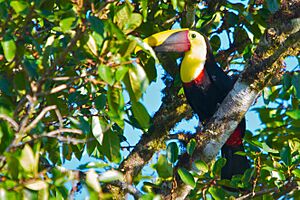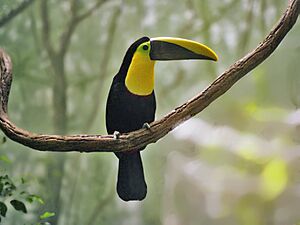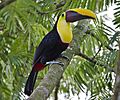Yellow-throated toucan facts for kids
Quick facts for kids Yellow-throated toucan |
|
|---|---|
 |
|
| R. a. swainsonii in Costa Rica | |
| Conservation status | |
| Scientific classification | |
| Genus: |
Ramphastos
|
| Species: |
ambiguus
|
| Subspecies | |
|
See text |
|
 |
|
The yellow-throated toucan (Ramphastos ambiguus) is a large, colorful bird that lives in the forests of Central and South America. It belongs to the toucan family, called Ramphastidae, which includes toucans, toucanets, and aracaris. This amazing bird can be found from Honduras all the way south to Peru. It is currently listed as a Near Threatened species, meaning its population is decreasing and it needs our help to survive.
Contents
What is a Yellow-Throated Toucan?
The yellow-throated toucan is a striking bird, known for its bright colors. It can grow to be about 47 to 61 centimeters (18 to 24 inches) long. That's about the length of your arm! It weighs between 584 to 746 grams (about 1.3 to 1.6 pounds), which is similar to a small pineapple.
How to Identify a Yellow-Throated Toucan
Most of this toucan's body is black, but it has a cool maroon tint on its neck and upper back. Its face, throat, and upper chest are a bright, sunny yellow. Below its yellow chest, you'll see white and crimson (dark red) bands. Its belly and the feathers under its tail are a vibrant red.
The skin around their eyes is also unique. Some toucans have sky-blue skin around their eyes, while others have yellow-green or bright green.
The Toucan's Amazing Beak
One of the most noticeable features of the yellow-throated toucan is its large, colorful beak. The top part of the beak (called the maxilla) is mostly yellow. It has a greenish-yellow stripe on top and a thin black line at the bottom.
The bottom part of the beak (the mandible) can be different colors depending on the type of yellow-throated toucan. Some have black mandibles, while others have a reddish-brown or maroon one. Even though their beaks are big, they are actually quite light!

Where Do Yellow-Throated Toucans Live?
Yellow-throated toucans live in different types of forests. They are found in evergreen primary forests, which are old, untouched forests. They also live in gallery forests (forests along rivers), older secondary forests (forests that have grown back after being cut down), and even parks and gardens with lots of trees.
They prefer humid (moist) forests and usually avoid dry areas or large open spaces. However, they might visit fruit plantations that are next to forests.
Toucan Habitats by Elevation
These toucans can be found at different heights above sea level:
- In Ecuador, some live from sea level up to 1,000 meters (3,300 feet).
- In Colombia, they live below 2,000 meters (6,600 feet).
- In Costa Rica, they are found up to 1,200 meters (3,900 feet).
Other types of yellow-throated toucans prefer higher elevations, living between 1,000 and 1,600 meters (3,300 and 5,200 feet) in Ecuador, and up to 2,500 meters (8,200 feet) in Colombia.
Toucan Behavior
Yellow-throated toucans usually stay in the same area all year round. They don't migrate to different places.
What Do Toucans Eat?
These toucans are mainly fruit eaters! They love to munch on all kinds of fruits found in the forest. They also eat small amounts of animal matter, like insects, spiders, small lizards, and even the eggs or young of other birds. They mostly feed these animal snacks to their baby toucans.
Toucans usually look for food high up in the forest canopy (the top layer of trees). They can be seen alone, in pairs, or in small groups. Sometimes, they even hop down to the ground to pick up fallen fruit. They are very clever and can hang upside down to reach tasty fruits! Even though they don't have territories, they often protect a single fruit tree if it's full of ripe fruit.
Reproduction and Life Cycle
The breeding season for yellow-throated toucans changes depending on where they live:
- In Costa Rica, they breed from March to June.
- In Panama and Colombia, it's from January to July.
- In Ecuador, it's between December and May.
During courtship, male toucans will preen (groom) the females and even offer them food as a gift! These birds nest in holes in trees that have formed from rot. They might make the hole a bit bigger, but they can't dig new ones. Their nests are usually high up, between 9 and 30 meters (30 to 98 feet) above the ground.
It's believed that female toucans lay two or three eggs. We don't know exactly how long the eggs take to hatch or how long it takes for the young birds to leave the nest. Both parent toucans work together to protect the nest and care for their babies.
Toucan Sounds
The main sound a yellow-throated toucan makes is a series of loud, far-carrying yelps. People have described their call as sounding like "Díos te dé te dé", which means "God give you" in Spanish. They make these calls all year round, usually from the tops of trees, especially around sunrise and sunset.
They also make other sounds like grunts, croaks, and loud rattles when they are showing aggression. When they fly, their wings make a rustling sound because of special notches in their outer feathers.
Conservation Status
The IUCN (International Union for Conservation of Nature) has listed the yellow-throated toucan as Near Threatened. This means that while they have a very large area where they live, their total number of birds is not known and is thought to be going down.
The biggest danger to these toucans is that their forest homes are being cut down for farms and ranches. Hunting is also a problem. Even though yellow-throated toucans can handle some changes to their environment, losing their habitat is still a major threat to their survival. We need to protect their forests to help these beautiful birds thrive!
Images for kids




